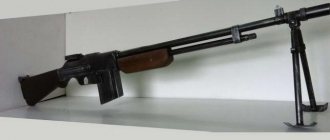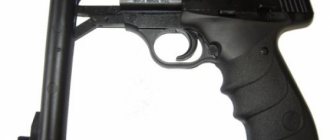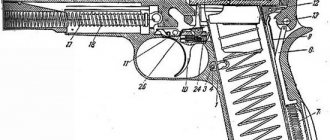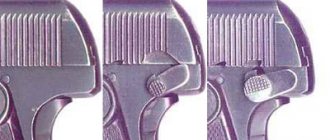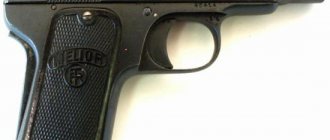Pistol FN Browning M 1900
| FN Browning Model 1899 |
Legendary American gunmaker John Moses Browning began designing short-barreled weapons in the mid-1890s, developing several self-loading pistols.
In 1897, he received several American patents for the design of pistols: - with a blowback, - using short-stroke recoil with locking by lowering the barrel, - using short-stroke recoil with locking by turning the barrel.
FN Browning M 1900 design diagram of the
Winchester pistol, with which Browning worked closely, did not work with pistols, so the designer turned his ideas to , whose management immediately became interested in his powerful pistol with reliable locking of the barrel, which had a good prospect of becoming a military-style weapon. The less impressive blowback pistol did not arouse much enthusiasm from Colt.
But the blowback design did not go unclaimed. A pistol of this design aroused the interest of the commercial director of the Belgian arms company FN (at that time called Fabrique Nationale d'Armes de Guerre). As a result, in mid-1897, a contract was concluded between the Belgian president and John Moses Browning, according to which Fabrique Nationale received the right to produce blowback pistols based on Browning's design.
| FN Browning M 1900 |
At the same time, according to Browning’s recommendations, the original version of his pistol was improved by Fabrique Nationale engineers and at the beginning of 1899 the production of this weapon was launched. Initially, the pistol was produced in two versions - with a barrel length of 102 mm and 122 mm.
| Caliber, mm | 7.65x17 |
| Length, mm | 163 |
| Height, mm | 115 |
| Width, mm | 31.5 |
| Barrel length, mm | 102 |
| Weight without cartridges, kg | 0.625 |
| Store, count. cartridges | 7 |
Along with the pistol, the 7.65 mm Browning (7.65×17 mm) cartridge, developed specifically for the Browning pistol, appeared on the arms and ammunition market, and became known in the USA as .32 ACP (.32 Colt Automatic Pistol).
The Belgian military became interested in a 7.65 mm pistol with a barrel length of 102 mm, but in order to accept it into service with the army, they required a number of changes to be made to the design of the weapon. As a result, a swivel for the safety cord appeared at the bottom of the pistol handle on the left side, corresponding inscriptions for the safety positions were applied - “fire” and “safety”, wider grip cheeks were used instead of the initially narrow ones, and other subtle changes were made (for example , frame shape and fuse type).
In 1900, Fabrique Nationale began producing an improved model of the Browning pistol, designated FN Browning model 1900 (FN Browning Mle 1900), also sometimes called Browning No 1, and adopted by the Belgian army.
| FN Browning M 1900 “MODELE DE LUXE” |
The automatic operation of the FN Browning M 1900 pistol operates on the principle of blowback.
The barrel is rigidly fixed in the frame and is motionless when firing. Due to the low-mounted barrel, the window for ejecting cartridges is located not in the bolt, but in the frame.
FN Browning M 1900 pistol device
The return spring is located above the barrel, and with its rear end, through a special lever, it acts on the firing pin, thus also acting as a mainspring.
The upper end of the lever connecting the recoil spring to the firing pin serves as an indicator for cocking the firing pin - when the firing pin is released, the lever covers the slot in the rear sight, blocking the line of sight.
The sighting devices are open type, non-adjustable, and consist of a front sight and rear sight.
The trigger mechanism is striker type, single action.
The mechanical fuse is of the flag type, located on the left side of the frame.
The weapon is fed with ammunition from detachable box magazines with a capacity of 7 rounds. The magazine latch is located at the lower rear of the handle.
There is a swivel on the left side of the weapon at the bottom of the handle.
Until 1905, the handle cheeks, made of plastic, included a copy of the weapon and the letter “FN” depicted on them. Subsequently, the cheeks were decorated only with the Fabrique Nationale monogram of intricately intertwined letters F and N.
| FN Browning M 1900 partial disassembly |
The FN Browning M 1900 pistol was widely used on the international arms market and was produced by Fabrique Nationale in huge quantities.
FN Browning M 1900
In 1900 it was adopted by the Belgian army. Since 1901, it began to be used by the Belgian gendarmerie. In 1903, this weapon was adopted by the police of a number of European countries. The pistol also gained enormous popularity in Russia - in 1907, officers of the tsarist army and navy were allowed to privately purchase and carry this weapon. However, the pistol is most widely used, as throughout the world, as a civilian weapon. It was sold with almost no formalities, and the small, flat Brownings quickly became a common weapon for the townspeople, police and postal officers.
Production of FN Browning M 1900 pistols ceased in 1912, and their total number produced by Fabrique Nationale exceeded 700,000 units.
The FN Browning model 1900 pistol was a durable, reliable and fairly simply designed weapon that combined compactness, lightness, good balancing, streamlined shapes, with the new 7.65 mm Browning cartridge, which had relatively good penetrating and stopping effect of the bullet for that time.
This pistol served as the prototype for most semi-automatic pistols, as well as pocket pistols and endless imitations. Many private businesses and small gunsmith shops copied the Browning Model 1900, both legally and illegally. A significant number of copies of this pistol were produced in Asia, mainly in China.
| FN Browning M 1900 |
FN M1900 - FN M1900
- USA (developed)
- Belgium (production)
The FN Browning M1900
is a single action, semi-automatic pistol designed with. 1896 by John Browning for Fabrique Nationale de Herstal (FN) and produced in Belgium around the turn of the century. It was the first production pistol to use a bolt action.
The name of the outstanding American designer John Moses Browning is associated with a number of different systems that played an important role in the development of weapons in the 20th century. But, perhaps, he made the greatest contribution to the formation and development of self-loading pistol systems. For a long time, the name “Browning” itself was perceived as synonymous with a self-loading pistol.
In the spring of 1895, John Moses Browning proposed a prototype of a blowback pistol he had created, but she did not dare to try it. In 1897, the commercial director of the Belgian (FN) Hart Berg traveled to the USA to familiarize himself with the production of bicycles. However, a more important discovery awaited him - in America he met the Browning family, and a self-loading pistol system arrived in Liege “on bicycle wheels.” On July 17, 1897, FN President Baron Charles de Marmol entered into an agreement with Browning, and in 1899, FN produced the first 7.65 mm “automatic” (in fact, self-loading) pistols. "Model 1900" dramatically changed the situation on the market for self-loading pistols, which had previously been formed by the Germans.
1900, when the Belgian FN released the Browning pistol onto the European market, and the German DWM the Luger-Borchard pistol, marked the beginning of a genuine “pistol boom”. 7.65 mm Browning pistols of 1900 became extremely popular, but mainly in the “civilian” market. At the beginning of their “career,” self-loading pistols had calibers of 7.63–8 mm. But soon an increase in calibers begins in order to increase the stopping effect of pistol bullets. Already in 1903, FN began producing the J.M. Browning model in 9 mm caliber, designed as a “military” model. It was a completely new model. It is worth noting that at the same time the same model, but with a caliber of 7.65 mm (chambered .32 ACP) was released in the USA.
The automatic pistol operated due to the recoil energy of the free bolt; the return spring was located under the barrel. Browning successfully applied the bolt-casing principle he had previously discovered - the “dead” mass of the bolt was moved forward, so that the bolt completely covered the barrel. The hammer-type trigger mechanism, with a hidden hammer, allowed a shot only with preliminary cocking: before the first shot, you need to jerk the bolt - at the same time the hammer is cocked, and the cartridge from the magazine is sent into the chamber of the barrel. The design of the trigger mechanism had three fuses. A non-automatic safety lever in the frame in the raised position blocked the trigger sear and the bolt. The trigger was locked only in the cocked position. Thus, it was possible to carry the pistol relatively safely with a cartridge in the chamber, the hammer cocked and the safety engaged. The inability to raise the safety lever indicated that the trigger was pulled. An automatic frame safety, designed as a push back wall of the handle, blocked the sear of the trigger mechanism and turned off when the handle was fully covered by the palm - contrary to some statements, it did not serve to “prevent suicide” (which would be very strange for a military pistol), but for the safety of unloading and service. The role of the third - also automatic - fuse was played by the disconnector of the trigger mechanism, which prevented a shot when the bolt did not reach the extreme forward position, i.e. when the bore is not completely locked.
The cartridges were fed from a detachable single-row magazine. When the cartridges were used up, the bolt delay was activated, holding the bolt in the open position. The handle had a ring for a safety cord or strap. There was a model with grooves at the bottom of the handle for attaching a rigid wooden holster-butt - a popular solution in those years for “military” pistols, which were supposed to be used in a kind of “carbine” version, especially in cavalry.
The cartridge for this pistol was initially called simply “9 mm Browning,” but after the appearance of the 9 mm “short” cartridge for the Model 1910 pistol, it began to be called “9 mm Browning long.” From 35 steps (about 25 m), the bullet pierced 6-7 inch pine boards: for comparison, a bullet from a 7.62 mm Nagan revolver pierced 3-4 boards. But over time, the 9-mm Browning Long cartridge could not compete with the 9-mm Parabellum cartridge.
The Browning Model 1903 was distinguished by good combat qualities with a relatively simple design (the design included 30 parts), reliable operation, ease of handling, and streamlined shape. It became very widespread, served as the basis for a lot of imitations, was in service in Belgium, the Netherlands, Serbia, Turkey, Paraguay, Peru, and a copy of it under the designation M/07 was produced in Sweden.
In Russia, the “Browning” model 1903 was also known as “Browning II sample” or “Browning No. 2” (“Browning” 1900 was considered the first sample). In 1907, the Browning 1903 was among the pistols officially allowed for officers to purchase at their own expense, “for wearing in the ranks.” In addition, it was centrally purchased in a version with a rigid holster-butt for arming the Separate Corps of Gendarmes and city police. In particular, it was in service with the Moscow Metropolitan Police - such a Browning can be found in the collection of the Central Museum of the Armed Forces in Moscow. Pistols were available in such large quantities that the Petrograd Cartridge Plant even produced 9-mm Browning Long cartridges for some time.
Pistols and revolvers of domestic and foreign production
Gunsmith Charles François Galan , who worked in Liege and Paris, made a notable contribution to the development of revolver design.
In 1872, he patented a double-action trigger mechanism, which was subsequently widely used throughout the world, particularly in England and Colt in the USA. He also developed a unique mechanism for extracting spent cartridges, which was used by many other manufacturers on the basis of a license. It was Galan who invented the Velodog revolver, the design of which was copied around the world more than any other model.
Pistols and revolvers of domestic and foreign production
- Russia (USSR)
- Argentina
- Austria
- Belgium
- Bulgaria
- Brazil
- Great Britain
- Hungary
- Venezuela
- Denmark
- Germany
- Israel
- Jordan
- Spain
- Italy
- Canada
- China
- Poland
- North Korea
- Serbia
- Slovakia
- USA
- Türkiye
- Ukraine
- France
- Finland
- Croatia
- Czech Republic (Czechoslovakia)
- Switzerland
- South Africa
- South Korea
- Japan


